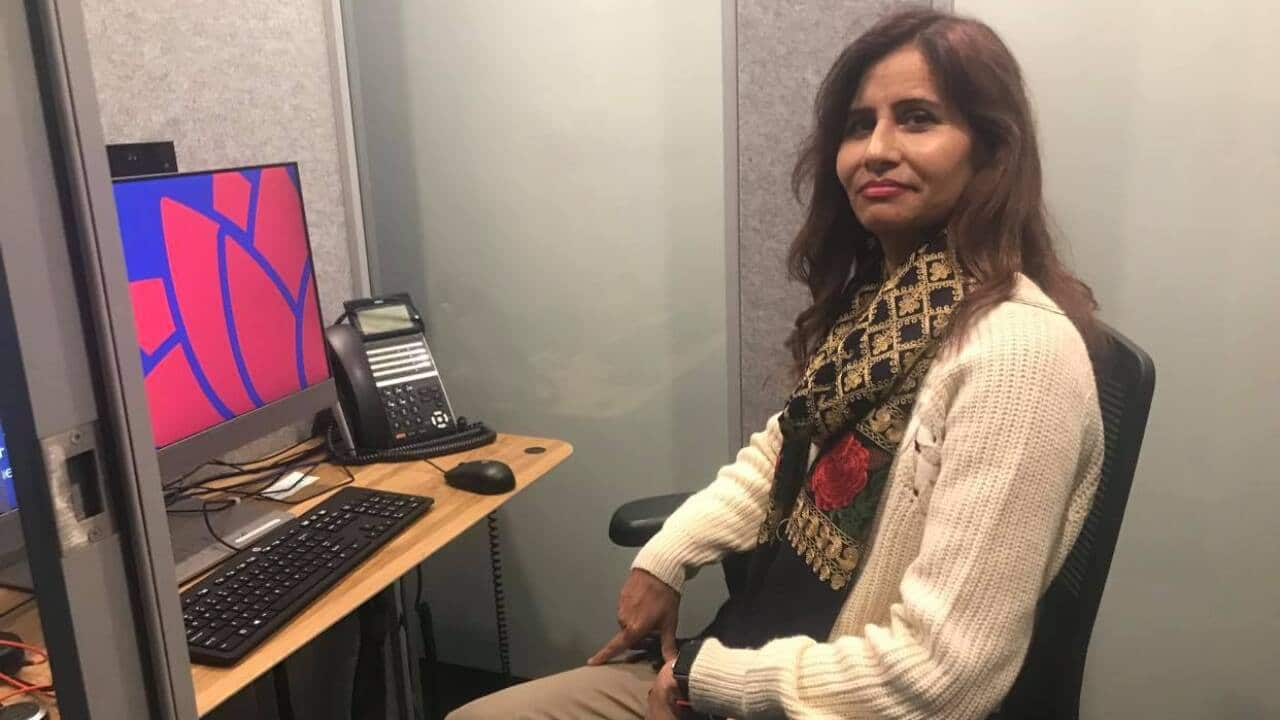From the comfort of her own lounge room, Nainaben Chandra is setting up in front of her computer for an appointment with her physio.
For the 69-year-old, who has osteoarthritis, telehealth sessions via video link have been essential during the coronavirus pandemic.
She connects to a virtual waiting room online where her clinician and Hindi interpreter join, both from different locations.
Ms Chandra said having an interpreter there for the session is very helpful and is much more effective than just having one over the phone. "It saves time on travelling and they help me understand things better via video," she told SBS News from her home in Quakers Hill, Sydney.
"It saves time on travelling and they help me understand things better via video," she told SBS News from her home in Quakers Hill, Sydney.

Nainaben Chandra now has her physio sessions with a clinician and a Hindi interpreter via video. Source: SBS News
"So we don’t have any problems."
Australians from non-English speaking backgrounds are statistically less likely to access health services regularly, which often leads to poorer health outcomes.
And with many people at home more often since the COVID-19 outbreak began in Australia, doctors are concerned even fewer people will be reaching out for help.
It has prompted Western Sydney's Local Health District to bring forward the release of its new myVirtualCare service for patients, which includes a three-way video interpreting platform.
Telehealth manager at the NSW Government's Agency for Clinical Innovation Donna Parkes, who helped build the new platform, said including interpreters in the service was imperative. "When we moved to the middle of COVID-19, video interpreting became essential really, because interpreters actually couldn't be there on the ground,” she said.
"When we moved to the middle of COVID-19, video interpreting became essential really, because interpreters actually couldn't be there on the ground,” she said.

Ms Chandra talks to her physio Natalia Ghosn and interpreter Balvinder Sidhu. Source: SBS News
“It's nice to be able to have access to an interpreter virtually ... or to open up that accessibility.”
Health professionals have welcomed the uptake in the technology, acknowledging telephone interpreting could sometimes be problematic.
Natalia Ghosn from Westmead Hospital is Ms Chandra’s physiotherapist. She said she is embracing the shift to online and that visual prompts make the sessions much better.
"I've worked with interpreters over the phone and with the video aspect, and by far having the video aspect makes it so much easier to communicate,” she said.
“Having an interpreter just by telephone leads to a lot of awkward silences.” Ms Ghosn said some practitioners were initially concerned about how some of their patients would fare using the technology, given many are in their 70s and 80s, but the response so far has been positive.
Ms Ghosn said some practitioners were initially concerned about how some of their patients would fare using the technology, given many are in their 70s and 80s, but the response so far has been positive.

Physiotherapist Natalia Ghosn is seeing a growing number of patients via video link. Source: SBS News
"We were worried about how technology may be a barrier in that setting, how we would work at communicating and how we would use interpreters. But it's been pleasantly surprising how well it's worked."
Dr Renu Narchal is a senior lecturer at Western Sydney University's school of psychology. She said the visual element is very important, and interpreting is not only about words.
"The body language is really important and also the emotions, and the facial expressions,” she said.
Dr Narchal did acknowledge that video interpreters may not be suitable for everyone.
“Some people might not want the video service because they do not want to be identified, depending on the nature of their appointment,” she said.
“In that instance, you could turn your camera off if there is an issue of being identified ... I think that would be the way to go.”
Since the pandemic began, Western Sydney Local Health District Interpreter Balvinder Sidhu has switched from nearly all face-to-face interpreting to four to five video sessions per day. "Most of my patients like video interpreting because it's more effective, more efficient, and especially patients who have limited access to transport, it's very convenient for them,” she said.
"Most of my patients like video interpreting because it's more effective, more efficient, and especially patients who have limited access to transport, it's very convenient for them,” she said.

Professional interpreter Balvinder Sidhu. Source: SBS News
Ms Sidhu said the platform is useful for various appointments, from diabetes check-ups to antenatal care.
“We are doing lots of antenatal visits for pregnant women. It can be with midwives, it can be with doctors, and they can get the same level of care as they would face-to-face."
Video interpreting in healthcare in Australia has, until now, been limited. But with the push for moving more health services online, it's expected to become much more popular.
The Royal Melbourne Hospital said its video-interpreting service has grown exponentially in the past few months.
“Prior to COVID-19, we were averaging around anywhere from 10 to 15 appointments a month,” its interpreter coordinator Christiana Leontiou said.
“We are now experiencing anywhere from 100-200 a month with continued growth.”
The federal government's national interpreting body, The Translating and Interpreting Service, is also about to expand its services, allowing healthcare service providers to book an interpreter for telehealth video appointments from August 2020.
SBS is committed to informing Australia’s diverse communities about the latest COVID-19 developments. News and information is available in 63 languages at




